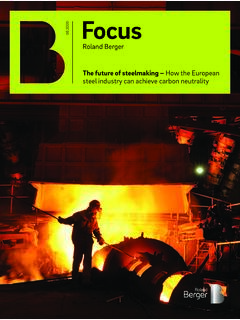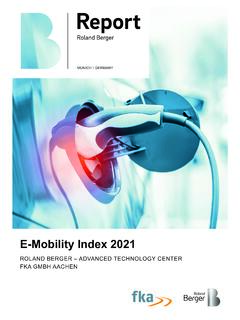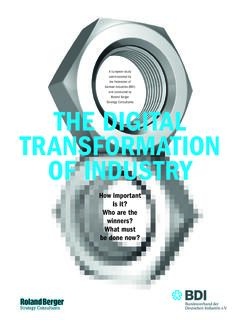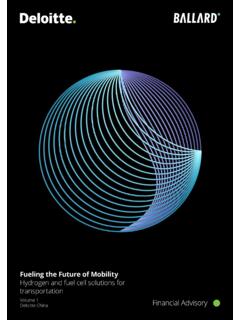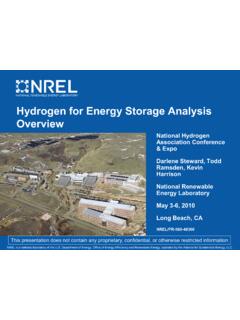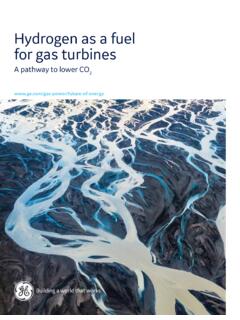Transcription of Hydrogen: A future fuel for aviation? - Roland Berger
1 | a future fuel for aviation ? hydrogen / a future fuel for aviation ? The aviation industry is at a crossroads. In the face of pressure to address its impact on climate change, the industry must respond: it must continue to improve current technologies, but also begin investing in greener, potentially revolutionary solutions. Among the many sustainable aviation technologies being considered from sustainable aviation fuels, to electric aircraft hydrogen has emerged as a potential aviation fuel of the future , with fuel cells and combustion options offering differing benefits. Which technological path should aerospace and aviation executives embark upon? Long aircraft development and certification lead times are driving a need for an urgent answer to this question.
2 To help executives navigate through this choice, we investigate the key issues and classify the different sustainable solutions for aviation , from "true zero" solutions to hybrid technologies. We then compare them, not just in terms of their environmental impact, but also their level of compatibility with current engines and aircraft designs. We recognize hydrogen as a genuine contender for power storage one that is increasingly being used not just in the aviation sector but in other industries too. Most hydrogen -based solutions under development use fuel cells rather than combustion, and we take a detailed look at what exactly each option has to to hydrogen as a fuel for aviation is not without its challenges, however.
3 We discuss the implications for aircraft and engine design, the necessity of effective hydrogen storage solutions, the need to produce hydrogen in a sustainable fashion, the infrastructure that will be required, and the associated costs. These are challenges that industry insiders should not indeed, must not underestimate. But we see clear potential for hydrogen aircraft, particularly in narrowbody/Middle-of-the-Market aircraft, which are likely to emerge as the battleground between hydrogen and hybrid-electric 's future will be informed by technology investment decisions many of which are to be made very soon that will shape the industry's future . Industry executives must thus stay abreast of the latest developments, and aware of the issues at stake, in order to shape the future of the SUMMARY 1 An industry in need of a revolution Could hydrogen be the answer?
4 2 aviation at a crossroads Which is the right path forward?3 hydrogen 's value proposition What benefits can hydrogen offer?4 hydrogen in aviation fuel cells or combustion?5 Five key barriers Where do the challenges lie?6 Looking ahead What does the future hold?4812162024 Cover photo dlnn/iStockHydrogen a future fuel for aviation ? |3 CONTENTSPAGE1An industry in need of a revolution / Could hydrogen be the answer?The aviation sector is in need of a revolution. Major industries such as energy and automotive are taking steps towards decarbonization, but aviation 's emissions continue to increase. Aircraft efficiency is improving, with fuel burn decreasing at approximately one percent a year, but aircraft fleet sizes are growing at around four percent a year.
5 Looking at the net effect, we estimate that aviation may be producing as much as 24 percent of global CO2 emissions by 2050, compared to roughly three percent today. Even with a hypothetical acceleration of improvements in aircraft efficiency to around percent per annum over twice today's pace we forecast that aviation could be producing 19 percent of global emissions by 2050. AThe aviation industry thus finds itself at a crossroads: it can continue to rely on conventionally-fueled gas turbines to propel flight a path that is likely to see significant resistance or it can choose to adopt greener modes of propulsion. In this study we discuss the potential for hydrogen as a fuel for aviation .
6 We begin by comparing the available emission reduction pathways for the aviation sector, including electrification and sustainable fuels. We then present the value proposition of hydrogen and compare the two key hydrogen propulsion methods: combustion and fuel cells. The former involves burning hydrogen instead of kerosene in a modified gas turbine; the latter involves producing electricity from hydrogen and oxygen inputs to power an electric motor that in turn drives a propeller or ducted fan. BWe then discuss the challenges created by hydrogen , including process efficiency, storage and cost, before finally laying out our expectations for the future of hydrogen : RCP, Secondary research, Roland BergerA: Two scenariosForecast increase in aviation 's share of global CO2 emissions1~3% aviation share of global CO2 emissions, 2019~5%~8%~24%Baseline: continued evolution at current paceAssuming a continuation of the status-quo in aerospace & aviation with regards to airline operations, fleet composition and aircraft/propulsion architectures.
7 Further assuming that the global fleet grows at ~4% , and new aircraft released into the market are ~1% more efficient year-on-year.~4%~6%~19%Accelerated evolution with system & airframe improvementsAssuming a faster efficiency improvement than the baseline case, with new technology becoming ~ more efficient year-on-year enabled by advances in airframe architecture, incremental improvements in engine technology, network and traffic management, and continued airline operational For each scenario, the range is obtained by considering different global emissions levels, via the Representative Concentration Pathways. Namely, RCP for the maximum value and RCP for the minimum value. The average of RCP and RCP is used to obtain the meanHydrogen - a future fuel for aviation ?
8 |5B: Two architecturesUsing hydrogen power for aircraft thrustHydrogen combustionThrustH2 + AirNOX + H20 + HeatSource: Roland BergerCompressorFanTurbineNozzleInputsCo mbustion chamberBy-products6 | FocusHydrogen fuel cellsThrustFanElectric motorInputsFuel cellsBatteryH20H2 + AirBy-productsHydrogen - a future fuel for aviation ? |72 aviation at a crossroads / Which is the right path forward?Efficiency & Operational ImprovementsHybrid-Electric AircraftOffsetsHydrogen fuel Cell3 More Electric AircraftHydrogen CombustionSustainable aviation Fuels (SAFs)Battery ElectricThere are five broad ways in which the aviation industry's emissions can be reduced, each with varying degrees of impact on carbon dioxide, and non-carbon greenhouse effects.
9 CContinued evolution: Solutions that offer incremental improvements on existing : Solutions that rely on the mitigation of carbon emissions elsewhere in the world, but without a reduction in gross hybrids: Solutions that move in the direction of electrification, with a partial reduction in all Greenhouse Gas (GHG) EVOLUTIONS everal methods that partly reduce green-house gas emissionsELECTRIC HYBRIDSP artial solution that reduces gross emissions by c. 10-50%NET-ZEROS olutions that reduce net emissions1 TRUE ZEROS olutions that reduce all gross emissions to zeroZERO CARBONS olutions that reduce carbon gross emissions2 to zeroC: Sustainable options for aviationSolutions fall into five broad include gas turbine efficiency improvements and air traffic control streamliningSmallLargeContinuing the trend of electrifying aircraft systems (excluding propulsion)SAFs: including biofuels, waste-to- fuel , and synthetic fuels (using hydrogen and carbon capture)Funding tree planting, renewable energy projects, etc, to mitigate CO2 emissionsHybrid-electric.
10 Including series or parallel hybrid aircraft requiring new engine and aircraft architecture (may also be compatible with SAFs)Powering all-electric aircraft with batteries only, using electricity generated from renewable sourcesConverting hydrogen and air to electricity, which powers a motor to drive propellersReplacing kerosene with hydrogen in modified jet enginesCHANGE IN EMISSION LEVELSE lectric pathHydrogen pathNet carbon reduction pathSource: Roland Berger1 Net emissions = Gross emissions produced by an entity minus any carbon sinks attributed to that entity; 2 Gross emissions = The actual emissions produced by an entity; 3 True zero only if hydrogen is produced from zero carbon sources and if the aircraft is operated a future fuel for aviation ?

